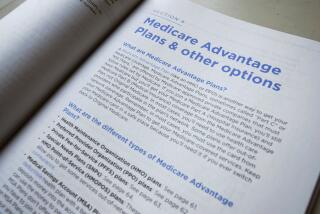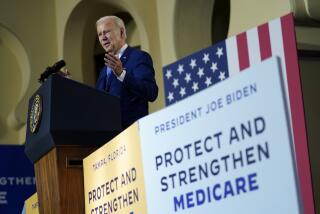Medicare to Screen for Alcoholism
WASHINGTON — Problem drinking among the elderly may cost Medicare more than $230 million a year to treat liver disease and other ailments, but only now will the huge healthcare program start covering routine screening for alcoholism.
Beginning this week, newly enrolled Medicare beneficiaries are eligible for an introductory physical that emphasizes prevention of conditions including alcoholism, depression, high blood pressure and diabetes.
The initial checkup after turning 65 is part of a broader effort to improve how doctors care for the elderly before Medicare is overwhelmed by the costs of the baby boomers. This year, Medicare begins covering preventive tests for diabetes and high cholesterol. And it is planning a national outreach campaign to emphasize prevention.
“The initial physical is intended to make Medicare into a prevention-oriented program,” said Medicare Administrator Mark B. McClellan.
Alcohol counseling may sound as if it belongs in a health plan for twentysomethings, not grandparents. But in fact, Medicare is behind the times. It has been nine years since the American Medical Assn. warned of a “hidden epidemic” of alcoholism among the elderly, estimating that about 3 million have drinking problems, and that many go undiagnosed.
Medicare’s omission of early alcohol screening is a part of a weak overall record on preventive care. For most of its history, the program excluded coverage of routine checkups. In the 1980s and 1990s, it began to cover some preventive services, such as flu shots, Pap smears and colon cancer screening.
This year, it finally begins to provide a range of services that resembles those available through employer-sponsored health plans.
Yet the congressional Government Accountability Office reported in the fall that few elderly beneficiaries were getting all the preventive care they were entitled to. For example, although 91% of women covered by Medicare received at least one preventive service, only 10% were screened for cervical, breast and colon cancer and also got flu and pneumonia immunizations.
“Prevention-oriented medicine is not the way Medicare has worked in the past,” McClellan acknowledged. “What we need to do now is close the gap in prevention as a result of people not taking advantage of all the new benefits. This is about the biggest deal we are undertaking.”
Dealing with problem drinking may be one of the toughest preventive challenges.
Signs of trouble, such as falls, can be mistaken for symptoms of an aging-related illness. Many patients are secretive about their drinking habits. Some have struggled with problems throughout their adult lives, though others begin drinking in old age because of loneliness or boredom.
“A lot of times, it’s closet-type drinking that has crept up on them over the years,” said Dr. J. Edward Hill, a family physician from Tupelo, Miss., and president-elect of the AMA. “You don’t think about old people having alcohol problems, but let me tell you, they do.”
He described the recent case of a woman in her early 80s living alone, who presented what appeared to be symptoms of dementia. At one point, her doctors suspected she had a tumor and ordered a brain scan. Nothing abnormal was found.
The puzzle was solved during a house call when one her doctors caught sight of an open cabinet lined with half-emptied bottles of hard liquor.
The woman’s problems went away as she was weaned off alcohol, Hill said, and she returned to her generally good state of health. A patient’s alcohol abuse can lead not only lead to false diagnosis of dementia and cause falls, but can also interfere with prescription medications.
One of the few major studies on problem drinking among Medicare beneficiaries found that hospitalization rates for alcohol-related illnesses were comparable to those for heart attacks. The study was published in 1993, but one of its authors said in an interview that the findings remained valid today.
“They are still applicable because I don’t think there has been a drastic change in human metabolism,” said Joseph Barboriak, a retired Veterans Administration scientist from New Berlin, Wis. “The elderly seem to be less able to metabolize alcohol.”
Now in his 80s, Barboriak said, “I stick to one drink a day.”
Using a Medicare database, Barboriak and his colleagues calculated that the program had spent at least $234 million on alcohol-related hospitalizations in 1989. Adjusting for inflation, the current cost could be between $300 million and $400 million. Medicare said it had no updated figure.
The government expects to pay between $20 million and $60 million for the new preventive benefits in 2005.
For some new beneficiaries, particularly those who were uninsured workers, the introductory physical could be their first medical checkup in years. But doctors will be paid $97.39 for each exam, and some question whether that is enough to cover the kind of checkup that can detect hidden problems.
“Ninety dollars for an initial physical is not a great deal of money,” said health economist Marilyn Moon of the American Institutes for Research, a nonprofit research organization. “These days, it’s not unusual to be talking $300 to $600 for a physical.”
Moon said the introductory exams were “a step in the right direction,” but she said preventive physicals should also be covered for older beneficiaries, especially those older than 75, and not just those joining the program. The GAO has cautioned that the physicals would be of questionable value unless there was also follow-up care.
Medicare has lately been struggling to promote some of its new benefits. Remarkably, only about 20% of those eligible have signed up for a $1,200 federal credit that low-income retirees can use to purchase medications. That benefit, made available for 2004 and 2005, was intended to provide a transition to prescription drug coverage that starts in 2006. But many beneficiaries apparently don’t know about it.
Such a lack of awareness could also cut the potential value of the new preventive benefits.
“There are two pieces to the puzzle,” said James Firman, head of the National Council on the Aging. “One is providing the coverage. The other is getting people to act on it. Prevention is an uphill battle.”
More to Read
Inside the business of entertainment
The Wide Shot brings you news, analysis and insights on everything from streaming wars to production — and what it all means for the future.
You may occasionally receive promotional content from the Los Angeles Times.










